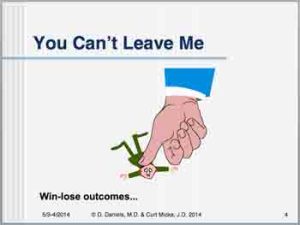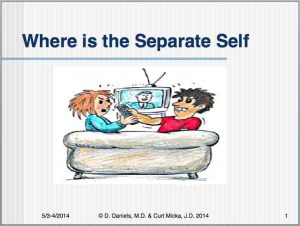On Having a Separate Self:
We Can’t Really Live With Someone If We Can’t Live Without Them, No Matter How Much We Believe We Love Them
Living on Borrowed Oxygen
We all need to develop a separate self with good personal boundaries. What does it mean to have good personal boundaries? It means having a distinct self with a sense of who we are individually. When absent or deficient, this easily overlooked core ingredient in relationships makes it difficult to work with all the other ingredients. Without this ingredient, we’re living on what I call “borrowed oxygen,” with the other person becoming, in a sense, our “must have it” oxygen supply. If you leave me, I’ll be without oxygen. So it goes from joy-mode to survival-mode, with me having to hold on to you at any cost. Borrowing oxygen from others keeps us from breathing on our own and takes away our own empowered ability to fully inhale and exhale – to truly give and receive – love. This is a set-up that leaves us limited, dependent, clinging, demanding, and even dominating. Just check out figures #1 and #2 below. I even have a saying that goes, “We Can’t Really Live With Someone If We Can’t Live Without Them, No Matter How Much We Believe We Love Them.” We each need to have, and be, our own definitive oxygen supply, one that the sustenance of our being, of our own aliveness, provides. As with the oxygen on our planet, as with the aliveness in our being, there is plenty of what’s needed for each of us.
Example: Marion and Robert
I readily recall the conflict between Marion and Robert, a couple I had been working with for a few weeks. I present this example without going into type since this ingredient is mostly unrelated to personality structure. There was no doubt Marion truly cared for Robert’s well-being. But every time she reached out to her co-ed bicycling group, he would explode in anger “How could you do this? What about me?” He hated cycling but felt intensely left out. His hurt feelings would simply escalate into angry outbursts that were actually threatening the relationship. She would then attack back, further polarizing and threatening their relationship (see figures #3 and #4). While Robert really cared about Marion, he needed to learn that he would be okay. He needed to expand into becoming his own oxygen supply – especially when they were not together or when either had an interest in different activities. That was his work.
Robert needed to learn that having a distinct, separate self promotes a self-reliance that engenders open, genuine communication, promotes psychological freedom, and keeps each other from getting bound in the constraints of egoic identifications. With a separate, distinct self, we become less possessive, less self-centered, less demanding, and far less confining of the other. With a distinctive, separate self we are capable of becoming what has been described as both a seeker (individual) and a merger (union) self wherein we can both represent our self as well as join with the other. We both breathe just fine on our own, as we too breathe fully when together.
 Building Unconditional Bonds
Building Unconditional Bonds
Our long period of dependency upon caregivers makes separateness a greater growth milestone for humans than other mammals. We all want care, nurture. It’s much preferred over the distress that arises when losing connection with someone we may need or want. If we don’t have an independent self, we are subject to feeling fearful and getting reactive when our connections are challenged, as is what happened with Robert. Our reactivity is really an attempt to get rid of the distress by temporarily amplifying, as Robert did. Additionally, take the distress of one experiencing growth while the other does not. If only one person in a relationship goes on the path of development, this can also become threatening and destabilizing as it threatens the state of the existing bond.
 Developing the Separate Self
Developing the Separate Self
Understanding the importance of setting good personal boundaries, as in breathing on our own, it’s what’s necessary to building unconditional bonds that support the each other’s growth and well-being. And how do we, as Robert needed to, develop a separate self? After years of struggling with this question, I know that it’s fundamentally through regular, thoughtful practice of the first two “As” of the Universal Growth Process – Awareness and Acceptance. It’s the ability to come back to grounded presence and do the work of personal inquiry from a stance of openhearted non-judgmentalness, knowing this does not mean that we must condon, capitulate, or concur with our own or the other’s behavior. In this inquiry, we need to remind ourselves of the importance of developing a distinct, separate self that lets go of the fear of being an individuated self. Add to this process conscious thoughts about what we are grateful for in self, other, and the world. This now is the third A: Appreciation. These three As, when practice, build the muscle that allows us to “breath on our own,” which then allows us to take genuine responsibility for our own part in the relationship, which allows us to participate fully. Robert did this, and step by step, his and Marion’s love blossomed anew.
LEND YOUR VOICE
I would love to hear from you, my blog readers, friends and colleagues.
What are your thoughts on this fundamental topic? How might you have struggled with these issues? What works for you? Please take a little time and add your thoughts, feelings, and point of view on this key topic.
Note: The figures included are from my colleague Curt Micka and our collaborative workshop on “The Enneagram and Mastering Conflict Constructively and Compassionately.”
To learn more about fostering fulfilling and loving relationships through the Enneagram and between different personality types while maintaining separate identities and distinct personal boundaries, check out Dr. David Daniel’s books The Enneagram, Relationships and Intimacy: Understanding one Another Leads to Loving Better and Living More Fully, co-written with Suzanne Dion, and The Enneagram Types Relationship Matrix.


